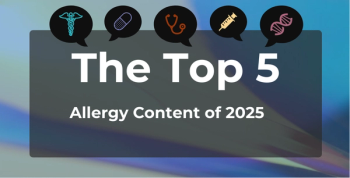
Case 1: Diagnosing and Treating Hepatitis C Virus Infection (CE)
Physician Credit
Accreditation Statement
This activity has been planned and implemented in accordance with the Essential Areas and policies of the Accreditation Council for Continuing Medical Education (ACCME) through the University of Cincinnati. The University of Cincinnati is accredited by the ACCME to provide continuing medical education for physicians.
Credit Designation
The University of Cincinnati designates this enduring material activity for a maximum of 1.0 AMA PRA Category 1 Credit™. Physicians should only claim credit commensurate with the extent of their participation in the activity.
If you have any questions, please contact Deborah Cole -
Pharmacy Credit
Pharmacy Times Office of Continuing Professional Education is accredited by the Accreditation Council for Pharmacy Education (ACPE) as a provider of continuing pharmacy education. This program is approved for 1.0 contact hour (0.1 CEU) under the ACPE universal program number of 0290-9999-11-025-H01-P. This program is available for CE credit through April 8, 2012.
If you have any questions regarding pharmacy credits, please contact
This activity is supported by an educational grant from Merck & Co, Inc.
Case 1: Diagnosing and Treating Hepatitis C Virus Infection
Eugene R. Schiff, MD, MACP, FRCP, MACG, AGAF
Professor of Medicine
Director, Schiff Liver Institute/Center for Liver Diseases
University of Miami Miller School of Medicine
Miami, Florida
Eugene R. Schiff, MD, MACP, FRCP, MACG, AGAF has disclosed the following:Scientific Advisory Board: Bristol-Myers Squibb, Gilead, GlobeImmune, Johnson & Johnson, Merck, Roche Molecular, Schering-Plough, Vertex; Data Safety Monitoring Board: Daiichi-Sankyo, Johnson & Johnson, Pfizer, Salix Pharmaceuticals, sanofi-aventis; Grants: Abbott, Anadys, Bristol-Myers Squibb, Gilead, GlobeImmune, Merck, Medtronic, Roche Diagnostics, Roche Molecular, Salix Pharmaceuticals, sanofi-aventis, Schering-Plough, SciClone Pharmaceuticals, Vertex The planning staff from the University of Cincinnati, The American Journal of Managed Care, and the Pharmacy Times Office of Continuing Professional Education have no relevant financial relationships to disclose.
Activity Overview
This activity reviews the clinical and economic burden of HCV infection and current therapies for HCV infection, describes challenges for managed care organizations and the cost-effectiveness of HCV infection treatment, and discusses upcoming and future therapies.
Please note the case presentation and supporting material have been created to be an engaging CE activity, and as such the case and questions will appear throughout. These questions are provided for your reference to be able to relate material presented back to a patient case presentation, and are not answerable on the case page. To answer the questions you will need to go to the posttest section, which will again reiterate the questions and provide you the opportunity to answer them.How to Obtain Credit
To receive your CE certificate, participants must view the entire activity online, complete the online 10†question posttest with a score of 70% or better, and complete the evaluation form. After successful completion of the online posttest and evaluation form, participants may immediately print their certificates.
Release Date: April 8, 2011
Expiration Date: April 8, 2012
Estimated time to complete: 1 hour
Type of Activity: Application
Targeted Audience
This activity is designed for medical directors, pharmacy directors, and other managed care professionals who oversee the care of patients with HCV infection.
Educational Objectives
After completing this activity, the participant should be able to:
- Describe the burden associated with hepatitis C virus infection
- Evaluate the efficacy of standard-of-care therapies in the management of HCV infection and efforts to optimize viral eradication in HCV-infected patients, thereby reducing disease burden
- Identify predictors of treatment outcomes, including the impact of genotype and adherence, to select and apply strategies to improve treatment response
Introduction
Hepatitis C virus (HCV) infection is the most common chronic blood-borne infection in the United States, and it is the leading cause of hepatocellular carcinoma and liver transplantation.1,2 Between 75% and 80% of individuals acutely infected with HCV will progress to chronic infection, and 60% to 70% to chronic liver disease.1,3
Patients who demonstrate serum HCV ribonucleic acid (RNA) for at least 6 weeks are diagnosed with chronic HCV infection. Symptoms may include fever, jaundice, fatigue, arthralgia, and anorexia, but most patients who are unaware of their HCV status do not exhibit any symptoms until the disease has been diagnosed. Moreover, symptoms usually do not correlate to serum alanine transaminase (ALT) levels or liver histology, although they tend to become more common and severe as cirrhosis develops.4,5
All individuals seen in medical settings should be screened for behavior that increases risk of HCV infection. Those who meet certain criteria (Table) should be tested for the virus and, if the results are positive, counseled on how to avoid transmission.6-8
Table. Individuals for Whom HCV Screening Is Recommended6,7
- Individuals who have ever injected drugs, even once
- Individuals with medical conditions associated with HCV infection, including: HIV infection Hemophilia, in those who received clotting factor concentrates prior to 1987 Hemodialysis Unexplained abnormal aminotransferase levels
- Individuals who received transfusions or organ transplants prior to July 1992, when screening programs for human tissue were implemented
- Children born to HCV-positive mothers
- Health care workers, including public safety workers, after a needle stick or mucosal exposure to HCV-positive blood
- Current sexual partners of HCV-infected individuals
Adapted from Centers for Disease Control and Prevention. MMWR Recomm Rep. 1998;47(RR-19):1-39; and Ghany MG, Strader DB, Thomas DL, et al. Hepatology. 2009;49(4):1335-1374.
CASE STUDY
CD is a 56-year-old female who presents with fatigue, fever, and arthralgia. She has been experiencing these symptoms for several weeks. She is 70 kg in weight, and has a body-mass index of 26. Physical examination findings were normal with the exception of mild hepatomegaly. You take a complete personal and medical history, and ask about prior drug use, sexual history, and whether she received a blood transfusion in the past. You learn that she experimented with intravenous drugs and was sexually promiscuous in her 20s. She has not used any illegal substances since her son was born 19 years ago, and continues in a monogamous relationship with the baby’s father. You order basic clinical laboratory tests. Results reveal normal complete blood count values and normal liver chemistries with the exception of ALT (48 U/L) and aspartate transaminase (35 U/L) levels.
1) Patients with HCV infection typically have what symptoms?
a) None, most patients who are unaware of their HCV status do not exhibit any symptoms until the disease has been diagnosed
b) Arthralgia
b) Fatigue
d) Anorexia
2) What clues tip you off that she may be infected with HCV?
a) She was sexually promiscuous
b) She was an intravenous drug user
c) She is in her 50s
d) All of the above
Testing for HCV
Current guidelines recommend that patients with suspected acute or chronic HCV infection first be tested for antibodies to HCV (anti-HCV). HCV RNA testing is recommended in those who tested positive for anti-HCV, those in whom antiviral treatment is being considered, and immunocompromised or other patients with unexplained liver disease and a negative anti-HCV test.6,9 Genotyping may be used once infection is confirmed to guide treatment and is recommended in all patients infected with HCV prior to interferon treatment.
Liver biopsy, considered the “gold standard” for identifying liver disease status, should be reserved for patients with chronic HCV only if information about the fibrotic status of the liver is required for treatment decisions. It is rarely required in patients with HCV genotype 2 or 3 infection, who are more likely to obtain a sustained virologic response (SVR) to treatment.6
3) What test do you order first to screen for HCV?
a) HCV RNA
b) Anti-HCV
c) Liver biopsy
d) Recombinant immunoblot
CASE STUDY (continued)
Based on CD’s history, you order a panel of tests, including those for sexually transmitted diseases and HCV infection. She tests positive for anti-HCV.
4) What is your next step?
a) Order an HCV RNA test
b) Begin treatment with interferon
c) Begin treatment with pegylated interferon
d) Begin treatment with pegylated interferon/ribavirin
5) The HCV RNA test is also positive. Should you order a liver biopsy?
a) No, because she clearly has chronic HCV infection and does not have evidence of decompensated liver disease.
b) Yes, because you need more information in order to begin treatment.
Current Standard of Care
The current standard of care for patients with chronic HCV infection is combination therapy with subcutaneous injections of peginterferon plus oral ribavirin (RBV) for 48 weeks.10-12 Recommended dosages are peginterferon alfa-2a at 180 µg per week, and RBV at a weight-based dosage of 1000 mg for those 75 kg or less in weight and 1200 mg for those weighing more than 75 kg. The dosage for peginterferon alfa-2b is 1.5 µg/kg per week, with a weight-based dosage of RBV at 800 mg for those less than 65 kg, 1000 mg for those more than 65 kg but less than 85 kg, 1200 mg for those between 85 kg and 105 kg, and 1400 mg for those more than 105 kg in weight.6
Although each agent carries the risk of serious side effects, risks are greater with combined therapy. Neutropenia and anemia are particularly concerning and should be monitored for throughout therapy; dose reductions are recommended if neutropenia occurs.10,13
Common side effects of therapy, such as influenza-like symptoms, coupled with depression, irritability, and insomnia, can lead to dose reduction and drug discontinuation.10,13 Such adverse affects, as well as individual patient characteristics, can lead to lower rates of treatment adherence and decreased efficacy over time.14-18 Another concern with pegylated interferon is the induction of autoimmune disorders, such as autoimmune thyroiditis.6
Because the adverse effects of combination therapy tend to increase over time, the shortest possible treatment time is recommended. Thus, guidelines call for discontinuing therapy in patients who do not achieve an early virologic response (EVR) at 12 weeks and retesting patients who do not achieve HCV RNA negativity at 24 weeks.11
There is a trend toward response-guided therapy, in which treatment duration is shortened or lengthened based on viral genotype, patient characteristics, and viral kinetics. For example, patients with HCV genotype 2 or 3 who demonstrate a rapid virologic response (RVR) at week 4 are significantly more likely to achieve a sustained virologic response (SVR) following a 16-week course of treatment. This shorter regimen is most effective in patients up to 45 years of age with low baseline HCV RNA levels (<400,000 IU/ml) and minimal fibrosis.19-22 Conversely, treatment duration may be extended to 72 weeks in patients with genotype 1 HCV infection, who may experience a delayed virus clearance.23 However, neither maintenance therapy or retreatment with peginterferon has been shown to be effective in nonresponders.6 After patients achieve SVR, they should still be regularly monitored for the development of hepatocellular cancer, particularly if they have cirrhosis.6
CASE STUDY (continued)
You decide to begin treatment with pegylated interferon/ribavirin.
6) If CD receives peginterferon alfa-2a, what is the recommended dose of RBV?
a) 800 mg
b) 1000 mg
c) 1200 mg
d) 1400 mg
7) While CD is on therapy, you regularly screen her for:
a) Anemia
b) Neutropenia
c) Depression
d) All of the above
8) After 11 weeks of therapy, CD complains of severe flu-like symptoms and says she can’t miss any more workdays and she wants to stop therapy. What do you tell her?
a) To hang in there for one more week, after which you will test her viral load and see if it is possible to stop
b) To stop treatment
c) That you will discontinue the ribavirin but she needs to remain on the interferon.
d) That you will switch her from the pegylated interferon to consensus interferon, which should help with her symptoms.
9) At 12 weeks, you test CD’s viral load to see if she’s had a(n):
a) SVR
b) End-of-treatment response
c) RVR
d) EVR
10) CD does not demonstrate an EVR. What do you recommend?
a) Continuing therapy with a higher dose of pegylated interferon
b) Continuing the current therapy for another 12 to 24 weeks
c) Switching to a higher dose of ribavirin
d) Stopping therapy
Educational Disclaimer:
Continuing professional education (CPE) activities sponsored by Pharmacy Times Office of CPE are offered solely for educational purposes and do not constitute any form of professional advice or referral. Discussions concerning drugs, dosages, and procedures may reflect the clinical experience of the author(s) or they may be derived from the professional literature or other sources and may suggest uses that are investigational in nature and not approved labeling or indications. Participants are encouraged to refer to primary references or full prescribing information resources.
The author(s), reviewer(s), and editor(s) have made extensive efforts to ensure that the information including treatments, drugs, and dosage regimens is accurate and conforms to the standards accepted at the time of publication. However, health care professionals should always consult additional sources of information and exercise their best professional judgment before making clinical decisions of any kind. In particular, the reader is advised to check the product information provided by the manufacturer of a drug product before prescribing or administering it, especially if the drug is unfamiliar or is used infrequently.
Instructions
After reading “Case 1: Diagnosing and Treating Hepatitis C Virus Infection (CE),” select the 1 best answer to each of the posttest questions.
A statement of continuing education hours will be provided to those physicians and pharmacists who successfully complete and return the answer form and program evaluation and receive a passing grade of 70% or higher.
References
- Centers for Disease Control and Prevention. Hepatitis C FAQs for Health Professionals. Last updated: December 17, 2010. http://www.cdc.gov/hepatitis/HCV/HCVfaq.htm#. Accessed February 8, 2011.
- Serfaty L, Aumaitre H, Chazouilleres O, et al. Determinants of outcome of compensated hepatitis C virus-related cirrhosis. Hepatology. 1998;27(5):1435-1440.
- Te HS, Jensen DM. Epidemiology of hepatitis B and C viruses: a global overview. Clin Liver Dis. 2010;14(1):1-21, vii.
- Merican I, Sherlock S, McIntyre N, et al. Clinical, biochemical and histological features in 102 patients with chronic hepatitis C virus infection. Q J Med. 1993;86(2):119-125.
- Shakil AO, Conry-Cantilena C, Alter HJ, et al. Volunteer blood donors with antibody to hepatitis C virus: clinical, biochemical, virologic, and histologic features. The Hepatitis C Study Group. Ann Intern Med. 1995;123(5):330-337.
- Ghany MG, Strader DB, Thomas DL, et al. Diagnosis, management, and treatment of hepatitis C: an update. Hepatology. 2009;49(4):1335-1374.
- Centers for Disease Control and Prevention. Recommendations for prevention and control of hepatitis C virus (HCV) infection and HCV-related chronic disease. MMWR Recomm Rep. 1998;47(RR-19):1-39.
- Centers for Disease Control and Prevention. National Hepatitis C Prevention Strategy 2001. http://digestive.niddk.nih.gov/ddiseases/pubs/chronichepc/index.htm. Accessed March 16, 2011.
- Alter MJ, Kuhnert WL, Finelli L. Guidelines for laboratory testing and result reporting of antibody to hepatitis C virus. Centers for Disease Control and Prevention. MMWR Recomm Rep. 2003;52(RR-3):1-13, 15; quiz CE11-14.
- Fried MW, Shiffman ML, Reddy KR, et al. Peginterferon alfa-2a plus ribavirin for chronic hepatitis C virus infection. N Engl J Med. 2002;347(13):975-982.
- Hadziyannis SJ, Sette H, Jr, Morgan TR, et al. Peginterferon-alpha2a and ribavirin combination therapy in chronic hepatitis C: a randomized study of treatment duration and ribavirin dose. Ann Intern Med. 2004;140(5):346-355.
- National Institutes of Health. NIH Consensus Statement on Management of Hepatitis C: 2002. http://www.nlm.nih.gov/archive//20061214/pubs/cbm/hepatitis_c_2002_2.html. Accessed March 16, 2011.
- Manns MP, McHutchison JG, Gordon SC, et al. Peginterferon alfa-2b plus ribavirin compared with interferon alfa-2b plus ribavirin for initial treatment of chronic hepatitis C: a randomised trial. Lancet. 2001;358(9286):958-965.
- McHutchison JG, Manns M, Patel K, et al. Adherence to combination therapy enhances sustained response in genotype-1-infected patients with chronic hepatitis C.Gastroenterology. 2002;123(4):1061-1069.
- Cacoub P, Ouzan D, Melin P, et al. Patient education improves adherence to peg-interferon and ribavirin in chronic genotype 2 or 3 hepatitis C virus infection: a prospective, real-life, observational study. World J Gastroenterol. 2008;14(40):6195-6203.
- Smith SR, Wahed AS, Kelley SS, et al. Assessing the validity of self-reported medication adherence in hepatitis C treatment. Ann Pharmacother. 2007;41(7):1116-1123.
- Weiss JJ, Brau N, Stivala A, et al. Review article: adherence to medication for chronic hepatitis C - building on the model of human immunodeficiency virus antiretroviral adherence research. Aliment Pharmacol Ther. 2009;30(1):14-27.
- Brett Hauber A, Mohamed AF, Beam C, et al. Patient preferences and assessment of likely adherence to hepatitis C virus treatment. J Viral Hepat. 2010.
- Shiffman ML, Suter F, Bacon BR, et al. Peginterferon alfa-2a and ribavirin for 16 or 24 weeks in HCV genotype 2 or 3. N Engl J Med. 2007;357(2):124-134.
- Yu ML, Dai CY, Huang JF, et al. A randomised study of peginterferon and ribavirin for 16 versus 24 weeks in patients with genotype 2 chronic hepatitis C. Gut. 2007;56(4):553-559.
- Lagging M, Langeland N, Pedersen C, et al. Randomized comparison of 12 or 24 weeks of peginterferon alpha-2a and ribavirin in chronic hepatitis C virus genotype 2/3 infection. Hepatology. 2008;47(6):1837-1845.
- Zeuzem S, Rizzetto M, Ferenci P, et al. Management of hepatitis C virus genotype 2 or 3 infection: treatment optimization on the basis of virological response. Antivir Ther. 2009;14(2):143-154.
- Tsubota A, Fujise K, Namiki Y, et al. Peginterferon and ribavirin treatment for hepatitis C virus infection. World J Gastroenterol. 2011;17(4):419-432.
Newsletter
Stay ahead of policy, cost, and value—subscribe to AJMC for expert insights at the intersection of clinical care and health economics.







































